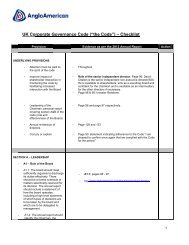ORE RESERVES AND MINERAL RESOURCESGLOSSARYRESOURCE TYPESAeolian:Diamond deposits created and enriched during transport of sediment through wind action (aeolian processes) resulting in theformation of wind blown dunes, ripples and sand sheets within which localised enrichment of diamonds may occur.Banded Iron Formation: A chemical sedimentary rock consisting of silica and iron oxide. The rock texture is characteristically laminated or banded.Beaches:Diamond deposits enriched through marine processes and preserved along the marine shoreline within a series of fossil terraces.Canga:An iron rich rock formed where material weathered from an original iron ore deposit has been cemented by iron minerals.Carbonatite Complex: A group of overlapping igneous intrusions of alkaline rocks including magmatic carbonate (sövite) rock. These complexes arefrequently host to phosphate, niobium and rare-earth element deposits.Colluvium:Loose, unconsolidated material that accumulates above the weathering iron ore bodies.Deflation:Diamond deposits enriched through wind driven removal of light particles resulting in concentration of diamonds.Ferruginous Laterite: An especially iron-rich laterite.Fluvial Placer:Diamond deposits formed and preserved within fossil sand and gravel terraces located adjacent to contemporary fluvial(river) systems.Fresh Rock:Mineable material that has not been significantly modified by surface weathering processes.Hematite: An iron oxide mineral with the chemical formula Fe 2 O 3 .Itabirite (Friable/Compact): Itabirite is a banded quartz hematite schist, very similar to banded iron formation in appearance and composition.Friable Itabirite is extensively weathered leading to disaggregation of the individual mineral grains comprising the rock.Compact Itabirite, previously known as Hard Itabirite, is the unweathered equivalent.Kimberlite:A potassic ultrabasic volcanic rock, emplaced as either pipes, dykes or sills, which sometimes contain diamonds.Laterite:A claylike soil horizon rich in iron and aluminium oxides that formed by weathering of igneous rocks under tropical conditions.Magnetite: An iron oxide mineral with the chemical formula Fe 3 O 4 .Main Sulphide Zone (MSZ): The Main Sulphide Zone is the principal host of Platinum Group Metals within the Great Dyke of Zimbabwe. The Main SulphideZone is a tabular zone of sulphide-bearing rock within the uppermost P1 Pyroxenite.Marine:Submerged diamond deposits enriched through fluvial (river), beach and marine reworking processes.Merensky Reef (MR): One of the three major Platinum Group Metals bearing units within the Bushveld Complex. The Merensky Reef is located withinthe Upper Critical Zone of the Bushveld Complex and ranges in width from 0.8m to 4m. The Merensky Reef occurs at theinterface between the Merensky Pyroxenite and the underlying anorthosite to norite. The Merensky Reef is characterised by theoccurrence of one or more narrow chromitite stringers and frequently includes a coarse-grained pegmatoidal pyroxenite.Oxide:Oxide ores are those found within close proximity to surface and whose mineralogy is dominated by oxidised species, includingoxides and sulphates. Frequently, silicate minerals have broken down partially or completely to clay-rich species.Platreef (PR):The Platreef is only present within the Northern Limb of the Bushveld Complex, in the vicinity of Polokwane, South Africa.The Platreef is a heterogenous unit dominated by felspathic pyroxenite, but including serpentinised pyroxenites and xenolithsof footwall rock. The Platreef dips steeply to the west and ranges in thickness between 60m and 200m. Platinum Group Metalmineralisation occurs disseminated within the Platreef and in frequent association with base-metal sulphides.Pocket Beach:Diamond deposits formed due to interactions of ocean (longshore) currents with specific shoreline topographic features thatfacilitate the concentration of diamonds.Porphyry (Copper):Large copper deposits hosted by intermediate felsic rocks. These deposits form close to large-scale subduction zones.Saprolite:Clay-rich rock formed by decomposition of pre-existing rocks within a surface weathering environment.Stockpile:Stockpiles resources comprise material that is mined together with the principal ore, but for economic or technical reasons is notprocessed. This material is stockpiled in preparation for processing when economic or technical conditions are more favourable.Sulphide:Sulphide ores contain sulphide minerals that have not been subjected to surface oxidation.Tailings:Material left over after the process of separating the valuable fraction of the mineralised material from the uneconomic fraction(gangue) of the run-of-mine. In some cases tailings can be re-treated to extract by-products.UG2 Reef (UG2):The UG2 Reef is located between 20m and 400m below the Merensky Reef and is the second chromitite unit within the UpperGroup. The UG2 is typically a massive chromitite unit ranging in thickness from 0.6m to 1.2m. The hangingwall of the UG2 is afelspathic pyroxenite unit that may include several narrow chromitite stringers. The footwall of the UG2 is a coarse-grainedpegmatoidal pyroxenite.COAL PRODUCTSMetallurgical – Coking:Metallurgical – Other:Thermal – Export:Thermal – Domestic:Synfuel:High-, medium- or low-volatile semi-soft, soft or hard coking coal primarily for blending and use in the steel industry; qualitymeasured as Crucible Swell Number (CSN).Semi-soft, soft, hard, semi-hard or anthracite coal, other than Coking Coal, such as pulverized coal injection (PCI) or othergeneral metallurgical coal for the export or domestic market with a wider range of properties than Coking Coal; quality measuredby calorific value (CV).Low- to high-volatile thermal coal primarily for export in the use of power generation; quality measured by calorific value (CV).Low- to high-volatile thermal coal primarily for domestic consumption for power generation; quality measured by calorificvalue (CV).Coal specifically for the domestic production of synthetic fuel and chemicals; quality measured by calorific value (CV).230 <strong>Anglo</strong> <strong>American</strong> plc <strong>Annual</strong> <strong>Report</strong> <strong>2012</strong>
OTHER INFORMATIONPRODUCTION STATISTICSThe figures below include the entire output of consolidated entities and the Group’s attributable share of joint ventures, joint arrangements and associateswhere applicable, except for Collahuasi in the Copper segment and De Beers which are quoted on a 100% basis.<strong>2012</strong> 2011Iron Ore and Manganese segment (tonnes)Kumba Iron Ore (1)(2)Lump 26,580,500 25,445,100Fines 16,484,600 15,822,500Total iron ore production 43,065,100 41,267,600Samancor (3)Manganese ore 3,347,800 2,786,800Manganese alloys (4) 198,400 300,500Coal (tonnes)Metallurgical Coal segmentAustraliaMetallurgical – Coking 10,484,700 9,290,400Metallurgical – Other (PCI) 5,802,700 3,963,000Thermal 12,970,500 13,426,50029,257,900 26,679,900CanadaMetallurgical – Coking 1,376,900 936,300Total Metallurgical Coal segment coal production 30,634,800 27,616,200Thermal Coal segmentSouth AfricaThermal – Export 17,132,100 16,328,400Thermal – Domestic (Eskom) 33,706,400 35,296,000Thermal – Domestic (non-Eskom) 6,219,100 5,059,700Metallurgical – Domestic 74,100 323,40057,131,700 57,007,500ColombiaThermal – Export 11,548,800 10,751,700Total Thermal Coal segment coal production 68,680,500 67,759,200Total coal production 99,315,300 95,375,400Coal (tonnes)Metallurgical Coal segmentAustraliaCallide 7,464,000 8,038,700Capcoal 6,022,400 5,047,900Dawson 4,593,500 3,904,600Drayton 3,663,300 3,991,900Foxleigh 1,896,000 1,417,100Jellinbah 2,073,200 1,829,600Moranbah North 3,545,500 2,450,10029,257,900 26,679,900CanadaPeace River Coal 1,376,900 936,300Total Metallurgical Coal segment coal production 30,634,800 27,616,200Thermal Coal segmentSouth AfricaGreenside 2,883,200 2,853,100Goedehoop 4,859,900 5,200,800Isibonelo 5,399,200 4,338,200Kriel 8,096,900 8,151,700Kleinkopje 3,765,500 4,400,600Landau 4,272,300 4,171,200New Denmark 3,401,200 4,812,600New Vaal 17,623,300 17,399,700Mafube 1,804,100 2,313,100Zibulo (5) 5,026,100 3,366,50057,131,700 57,007,500(1)Kolomela commenced commercial production on 1 December 2011. Revenue and related costs associated with 984,700 tonnes of production were capitalised for the year ended31 December 2011.(2)In <strong>2012</strong> Amapá has been reclassified from Iron Ore and Manganese to Other Mining and Industrial to align with internal management reporting. Comparatives have been reclassified to alignwith current presentation.(3)Saleable production.(4)Production includes Medium Carbon Ferro Manganese.(5)Zibulo commenced commercial production on 1 October 2011. Revenue and related costs associated with 2,155,200 tonnes of production were capitalised before commercial production wasreached in 2011. This included Eskom coal production of 633,400 tonnes and export thermal coal production of 1,521,800 tonnes.Other information<strong>Anglo</strong> <strong>American</strong> plc <strong>Annual</strong> <strong>Report</strong> <strong>2012</strong> 231
- Page 1 and 2:
A BALANCEDPORTFOLIOWITH THE FUTURE
- Page 4 and 5:
HeadquartersLondon,United KingdomCo
- Page 6 and 7:
OVERVIEW CHAIRMAN’S STATEMENTCHAI
- Page 8 and 9:
OVERVIEW MARKETPLACEA BRIGHTER OUTL
- Page 10 and 11:
OVERVIEW MARKETPLACEWELL PLACED FOR
- Page 12 and 13:
OVERVIEW OUR STRATEGY AND BUSINESS
- Page 14 and 15:
OVERVIEW CHIEF EXECUTIVE’S STATEM
- Page 16 and 17:
OPERATING AND FINANCIAL REVIEW KEY
- Page 18 and 19:
OPERATING AND FINANCIAL REVIEW STRA
- Page 20 and 21:
OPERATING AND FINANCIAL REVIEW STRA
- Page 22 and 23:
OPERATING AND FINANCIAL REVIEW STRA
- Page 24 and 25:
OPERATING AND FINANCIAL REVIEW STRA
- Page 26 and 27:
OPERATING AND FINANCIAL REVIEW STRA
- Page 28 and 29:
OPERATING AND FINANCIAL REVIEW STRA
- Page 30 and 31:
OPERATING AND FINANCIAL REVIEW STRA
- Page 32 and 33:
OPERATING AND FINANCIAL REVIEW STRA
- Page 34 and 35:
OPERATING AND FINANCIAL REVIEW STRA
- Page 36 and 37:
OPERATING AND FINANCIAL REVIEW STRA
- Page 38 and 39:
OPERATING AND FINANCIAL REVIEW STRA
- Page 40 and 41:
OPERATING AND FINANCIAL REVIEW RESO
- Page 42 and 43:
OPERATING AND FINANCIAL REVIEW RESO
- Page 44 and 45:
OPERATING AND FINANCIAL REVIEW RESO
- Page 46 and 47:
OPERATING AND FINANCIAL REVIEW GROU
- Page 48 and 49:
OPERATING AND FINANCIAL REVIEW GROU
- Page 50 and 51:
OPERATING AND FINANCIAL REVIEW GROU
- Page 52 and 53:
OPERATING AND FINANCIAL REVIEW RISK
- Page 54 and 55:
OPERATING AND FINANCIAL REVIEW RISK
- Page 56 and 57:
OPERATING AND FINANCIAL REVIEW RISK
- Page 58 and 59:
OPERATING AND FINANCIAL REVIEW IRON
- Page 60 and 61:
OPERATING AND FINANCIAL REVIEW IRON
- Page 62 and 63:
OPERATING AND FINANCIAL REVIEW IRON
- Page 64 and 65:
OPERATING AND FINANCIAL REVIEW META
- Page 66 and 67:
OPERATING AND FINANCIAL REVIEW META
- Page 68 and 69:
OPERATING AND FINANCIAL REVIEW THER
- Page 70 and 71:
OPERATING AND FINANCIAL REVIEW THER
- Page 72 and 73:
OPERATING AND FINANCIAL REVIEW COPP
- Page 74 and 75:
OPERATING AND FINANCIAL REVIEW COPP
- Page 76 and 77:
OPERATING AND FINANCIAL REVIEW NICK
- Page 78 and 79:
OPERATING AND FINANCIAL REVIEW NICK
- Page 80 and 81:
OPERATING AND FINANCIAL REVIEW PLAT
- Page 82 and 83:
OPERATING AND FINANCIAL REVIEW PLAT
- Page 84 and 85:
OPERATING AND FINANCIAL REVIEW PLAT
- Page 86 and 87:
OPERATING AND FINANCIAL REVIEW DIAM
- Page 88 and 89:
OPERATING AND FINANCIAL REVIEW DIAM
- Page 90 and 91:
OPERATING AND FINANCIAL REVIEW OTHE
- Page 92 and 93:
OPERATING AND FINANCIAL REVIEW OTHE
- Page 94 and 95:
GOVERNANCE INTRODUCTIONGOVERNANCESi
- Page 96 and 97:
GOVERNANCE THE BOARDTHE BOARDCHAIRM
- Page 98 and 99:
GOVERNANCE EXECUTIVE MANAGEMENTEXEC
- Page 100 and 101:
GOVERNANCE ROLE OF THE BOARDTHE ROL
- Page 102 and 103:
GOVERNANCE BOARD IN ACTIONBOARD VIS
- Page 104 and 105:
GOVERNANCE BOARD IN ACTIONBOARDCOMM
- Page 106 and 107:
GOVERNANCE BOARD IN ACTIONNOMINATIO
- Page 108 and 109:
GOVERNANCE AUDIT COMMITTEE REPORTAU
- Page 110 and 111:
GOVERNANCE AUDIT COMMITTEE REPORTOb
- Page 112 and 113:
GOVERNANCE DIRECTORS’ REMUNERATIO
- Page 114 and 115:
GOVERNANCE DIRECTORS’ REMUNERATIO
- Page 116 and 117:
GOVERNANCE DIRECTORS’ REMUNERATIO
- Page 118 and 119:
GOVERNANCE DIRECTORS’ REMUNERATIO
- Page 120 and 121:
GOVERNANCE DIRECTORS’ REMUNERATIO
- Page 122 and 123:
GOVERNANCE DIRECTORS’ REMUNERATIO
- Page 124 and 125:
GOVERNANCE DIRECTORS’ REMUNERATIO
- Page 126 and 127:
GOVERNANCE DIRECTORS’ REMUNERATIO
- Page 128 and 129:
GOVERNANCE DIRECTORS’ REMUNERATIO
- Page 130 and 131:
GOVERNANCE DIRECTORS’ REMUNERATIO
- Page 132 and 133:
GOVERNANCE DIRECTORS’ REPORTDIREC
- Page 134 and 135:
GOVERNANCE DIRECTORS’ REPORTEMPLO
- Page 136 and 137:
GOVERNANCE DIRECTORS’ REPORTIssue
- Page 138 and 139:
GOVERNANCE STATEMENT OF DIRECTORS
- Page 140 and 141:
FINANCIAL STATEMENTSRESPONSIBILITY
- Page 142 and 143:
FINANCIAL STATEMENTS PRINCIPAL STAT
- Page 144 and 145:
FINANCIAL STATEMENTS PRINCIPAL STAT
- Page 146 and 147:
FINANCIAL STATEMENTSNOTES TO THE FI
- Page 148 and 149:
FINANCIAL STATEMENTS NOTES TO THE F
- Page 150 and 151:
FINANCIAL STATEMENTS NOTES TO THE F
- Page 152 and 153:
FINANCIAL STATEMENTS NOTES TO THE F
- Page 154 and 155:
FINANCIAL STATEMENTS NOTES TO THE F
- Page 156 and 157:
FINANCIAL STATEMENTS NOTES TO THE F
- Page 158 and 159:
FINANCIAL STATEMENTS NOTES TO THE F
- Page 160 and 161:
FINANCIAL STATEMENTS NOTES TO THE F
- Page 162 and 163:
FINANCIAL STATEMENTS NOTES TO THE F
- Page 164 and 165:
FINANCIAL STATEMENTS NOTES TO THE F
- Page 166 and 167:
FINANCIAL STATEMENTS NOTES TO THE F
- Page 168 and 169:
FINANCIAL STATEMENTS NOTES TO THE F
- Page 170 and 171:
FINANCIAL STATEMENTS NOTES TO THE F
- Page 172 and 173:
FINANCIAL STATEMENTS NOTES TO THE F
- Page 174 and 175:
FINANCIAL STATEMENTS NOTES TO THE F
- Page 176 and 177:
FINANCIAL STATEMENTS NOTES TO THE F
- Page 178 and 179:
FINANCIAL STATEMENTS NOTES TO THE F
- Page 180 and 181:
FINANCIAL STATEMENTS NOTES TO THE F
- Page 182 and 183:
FINANCIAL STATEMENTS NOTES TO THE F
- Page 184 and 185: FINANCIAL STATEMENTS NOTES TO THE F
- Page 186 and 187: FINANCIAL STATEMENTS NOTES TO THE F
- Page 188 and 189: FINANCIAL STATEMENTS NOTES TO THE F
- Page 190 and 191: FINANCIAL STATEMENTS NOTES TO THE F
- Page 192 and 193: FINANCIAL STATEMENTS NOTES TO THE F
- Page 194 and 195: FINANCIAL STATEMENTS NOTES TO THE F
- Page 196 and 197: ORE RESERVES AND MINERAL RESOURCESE
- Page 198 and 199: ORE RESERVES AND MINERAL RESOURCESE
- Page 200 and 201: ORE RESERVES AND MINERAL RESOURCESI
- Page 202 and 203: ORE RESERVES AND MINERAL RESOURCESI
- Page 204 and 205: ORE RESERVES AND MINERAL RESOURCESC
- Page 206 and 207: ORE RESERVES AND MINERAL RESOURCESC
- Page 208 and 209: ORE RESERVES AND MINERAL RESOURCESC
- Page 210 and 211: ORE RESERVES AND MINERAL RESOURCESC
- Page 212 and 213: ORE RESERVES AND MINERAL RESOURCESC
- Page 214 and 215: ORE RESERVES AND MINERAL RESOURCESC
- Page 216 and 217: ORE RESERVES AND MINERAL RESOURCESC
- Page 218 and 219: ORE RESERVES AND MINERAL RESOURCESP
- Page 220 and 221: ORE RESERVES AND MINERAL RESOURCESP
- Page 222 and 223: ORE RESERVES AND MINERAL RESOURCESD
- Page 224 and 225: ORE RESERVES AND MINERAL RESOURCESD
- Page 226 and 227: ORE RESERVES AND MINERAL RESOURCESP
- Page 228 and 229: ORE RESERVES AND MINERAL RESOURCESR
- Page 230 and 231: ORE RESERVES AND MINERAL RESOURCESR
- Page 232 and 233: ORE RESERVES AND MINERAL RESOURCESD
- Page 236 and 237: OTHER INFORMATION PRODUCTION STATIS
- Page 238 and 239: OTHER INFORMATION PRODUCTION STATIS
- Page 240 and 241: OTHER INFORMATIONEXCHANGE RATES AND
- Page 242 and 243: OTHER INFORMATIONKEY FINANCIAL DATA
- Page 244 and 245: OTHER INFORMATIONRECONCILIATION OF
- Page 246 and 247: OTHER INFORMATIONTHE BUSINESS - AN
- Page 248 and 249: OTHER INFORMATIONSHAREHOLDER INFORM
- Page 250: Anglo American plc20 Carlton House



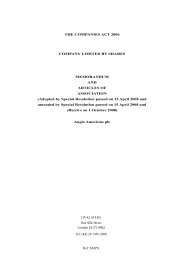
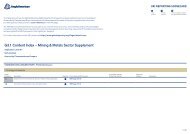
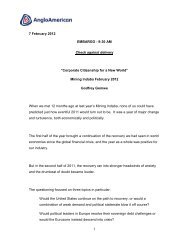
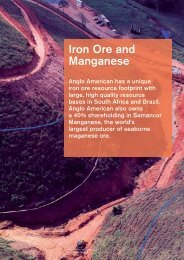
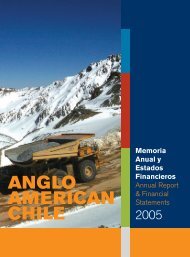
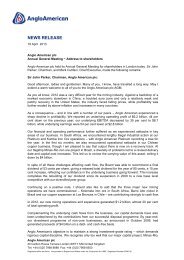
![English PDF [ 189KB ] - Anglo American](https://img.yumpu.com/50470814/1/184x260/english-pdf-189kb-anglo-american.jpg?quality=85)
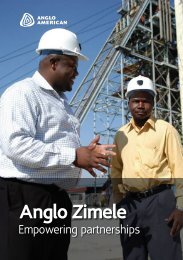

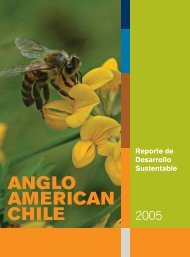
![pdf [ 595KB ] - Anglo American](https://img.yumpu.com/49420483/1/184x260/pdf-595kb-anglo-american.jpg?quality=85)
![pdf [ 1.1MB ] - Anglo American](https://img.yumpu.com/49057963/1/190x240/pdf-11mb-anglo-american.jpg?quality=85)
